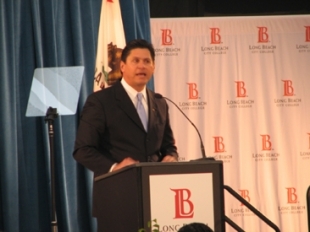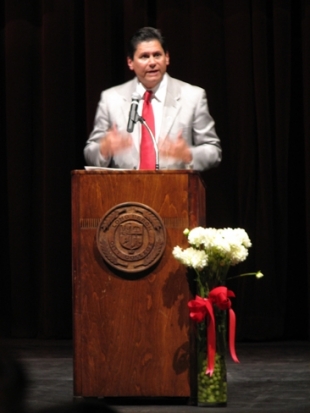 The definition of leadership is elusive, often difficult to pin down. Not because it is hard to recognize, but because it manifests itself in so many different qualities. Ironically, as hard as it is to define, leadership can be spotted fairly easily. Often described as the “it” quality, people who possess it are leading causes, communities, businesses, public organizations and higher education institutions.
The definition of leadership is elusive, often difficult to pin down. Not because it is hard to recognize, but because it manifests itself in so many different qualities. Ironically, as hard as it is to define, leadership can be spotted fairly easily. Often described as the “it” quality, people who possess it are leading causes, communities, businesses, public organizations and higher education institutions.
When you to talk to Eloy Oakley, President of Long Beach City College, the “it” quality clearly comes through. Recently, I had the opportunity to sit down with President Oakley to discuss his role, his vision for LBCC and the state of the California community college system. This is what I gleaned from that conversation: the man behind the title is a man on a mission. By his own admission, the presidency is “less powerful than the title conjures up… you have to convince people to follow your vision.” He views his role as creating momentum and getting people behind it. For President Oakley, this ability comes naturally. Although he could not have predicted his ascent in higher education when he was a youth growing up in South Gate and Huntington Park, his background and life story would lead you to believe that he was born to lead a community college.
Having grown up in a family scarce in college graduates, President Oakley enlisted in the U.S. Army after graduating from high school. He held odd jobs after being discharged until he enrolled at a community college not too far from here, Golden West College. Shortly thereafter, he transferred to the University of California, Irvine, where he received a bachelor’s degree in environmental analysis and design and, later, an MBA. He credits his time at Golden West College as the turning point in his life. It was that experience that presented him with the mission he now vigorously and proudly pursues: to give back to the community college system that gave him direction and to make it more effective in preparing today’s students to succeed.
As Superintendent-President of one of California’s largest community college districts, President Oakley has the daunting task of leading an organization whose missions are varied, student body is diverse, and whose budget was recently slashed by Sacramento. In spite of the challenges – which President Oakley admits are many – he says with a straight face that if he wasn’t president, he would still be the Assistant Superintendent/Executive Vice President of Administrative Services at LBCC (the job he had before being appointed president) or a president at another college. For him, leading a college is not just a job – it’s a mission.
Higher education institutions are different from businesses and other government organizations. They operate within an environment characterized by excessive layers of bureaucracy. President Oakley admits that “the rules of the game are different.” When asked to elaborate, he said that leading community colleges is a “very collegial process”. In addition to managing his administrative staff, President Oakley oversees the faculty and all classified employees and answers to an elected board of trustees. To lead effectively, he must get the buy-in from different groups who don’t always share the same interests. This is where the “collegial” part plays in. Interestingly, he likens the structure of the community college to that of a hospital. He compares the role of the community college president to the hospital administrator who must find a nexus between physicians and the administration. As president of the college, President Oakley constantly looks for ways to draw the attention and support of the board of trustees, faculty and the staff around issues he believes are important to the success of the college.
 Since he brought up the hospital, I took the liberty of asking President Oakley whether California’s public education system was due for reform, along the lines of health care reform. Without hesitation, he said, “Yes!” Realizing I had just opened the door to a topic he seemed more than willing to discuss, I asked him what reform would look like if he was leading the charge. His response? “Many unhappy people.” Of course, he was referring to the reaction he would expect to the changes that he would implement. Clearly, President Oakley is not reluctant to work through the system to reach his goals. At the same time, he is not one to shy away from confrontation and not afraid to ruffle a few feathers in the name of improving public education for students.
Since he brought up the hospital, I took the liberty of asking President Oakley whether California’s public education system was due for reform, along the lines of health care reform. Without hesitation, he said, “Yes!” Realizing I had just opened the door to a topic he seemed more than willing to discuss, I asked him what reform would look like if he was leading the charge. His response? “Many unhappy people.” Of course, he was referring to the reaction he would expect to the changes that he would implement. Clearly, President Oakley is not reluctant to work through the system to reach his goals. At the same time, he is not one to shy away from confrontation and not afraid to ruffle a few feathers in the name of improving public education for students.
Under his vision for reform, the expectations for schools and students would be redefined. All segments of public education – K-12, community college and the four-year California university systems – would be better aligned to provide clear pathways for students. Missions would also be clearer and more focused. Additionally, the value of a high school diploma would be the same across the state as would the definition of “college-ready”. “We’ve allowed the system to grow independently,” President Oakley says. “And that has created a barrier for many students who would otherwise pursue a college education.”
Admittedly, President Oakley has his own share of challenges at LBCC. The percentage of students who earn an associate’s degree or move on to a four-year university is relatively low. Part of this is due to the college’s many missions and diverse student body, he says. In response, President Oakley has implemented several programs to improve graduation and transfer rates on campus. His goal is to help all students succeed in reaching their academic goals, whether it’s an associate’s or bachelor’s degree or personal enrichment in a particular subject matter. “The issue is no longer about access,” he says, “it’s about having resources to make sure students complete successfully.”
Not being one to just stand by, criticize and complain, in his relatively short tenure, President Oakley has already taken bold steps to improve education locally. Last year, he joined CSULB President F. King Alexander and LBUSD Superintendent Chris Steinhauser in a historic effort to integrate the three segments of public education under the banner of the “Long Beach College Promise.” Under this partnership, every LBUSD student is guaranteed a tuition-free first semester at LBCC. The goal of this program is to get middle school students – as early as sixth grade – thinking about college. In turn, LBCC students who meet the minimum CSU requirements are guaranteed a place at Long Beach State. This program not only aligns the three segments of public education; it also clarifies the pathways between the three and creates incentives for students early in their education. Just recently, President Oakley also partnered with CSU Dominguez Hills President Dr. Mildred Garcia to sign the “Pathways to Success Pledge.” The agreement marks a new partnership between the institutions with the goal of increasing transfer success and bachelor’s degree attainment for LBCC students.
Leading community colleges has never been easy and it hasn’t gotten any easier today. A paper titled Changing Role of the Community College President in the Face of New Administrative Pressures says that the problems community college presidents must deal with “will not go away and will become more pronounced.” That was written in 1976, so you can imagine how much more complex leading a community college has become. The same article says that “[l]eadership in the field has a continuing task of interpreting the institution to many publics.” In President Eloy Oakley, we have a leader who not only interprets the institution – he is constantly shaping it in order to meet the demands of the 21st century economy. Thankfully, Long Beach City College and the communities it serves have an entrepreneurial, visionary and reform-minded leader who is not afraid to challenge the status quo to reach the results he feels the community college should be producing for its students and the communities it serves.
This much is clear: President Oakley is not waiting for reform to happen – he’s making it happen here in Long Beach. He knows his mission and he’s leading the charge. Like a good soldier, he will continue marching forward until the mission is accomplished.
Reference: Rushing, Joe B. (1976). “Changing Role of the Community College President in the Face of New Administrative Pressures.” AACJC Publications, P. O. Box 298, Alexandria, Virginia 22314 (p.57).
Note: Special thanks to Chi-Chung Keung, LBCC’s Executive Director of Public Affairs and Marketing, for coordinating the interview and to him and Mark Taylor, LBCC’s Director of Community and Government Relations, for supplying helpful information.
Disclosure: staging-live.lbpost.com co-founder and Long Beach City Councilmember Robert Garcia is a Long Beach City College employee. Click here to read our policy on covering the Long Beach City Council.

